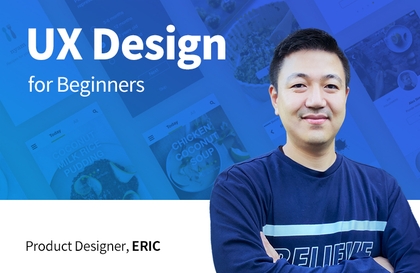
ニューヨークプロダクトデザイナーが知らせる、入門者のためのUXデザインの概論
uxeric
デザインを勉強してみたことのない非専攻者の方、今ちょうどUXデザインを勉強し始めた学生たち、UXとUIデザインの就学生の方のためのUXデザインの概論授業です。早い時間内に基本機が充実したUX、UIデザイナーになるための方法を実務者の観点から "大放出"させていただきます。
Beginner
Web Design, Mobile App Design
This is a class called "UI Design with Figma A to Z" prepared for non-majors who have never studied design, students who have just started studying UX design, and UX and UI design job seekers. Even those who do not know any other tools such as Photoshop can become UI design experts by using only Figma, from basic to advanced functions.
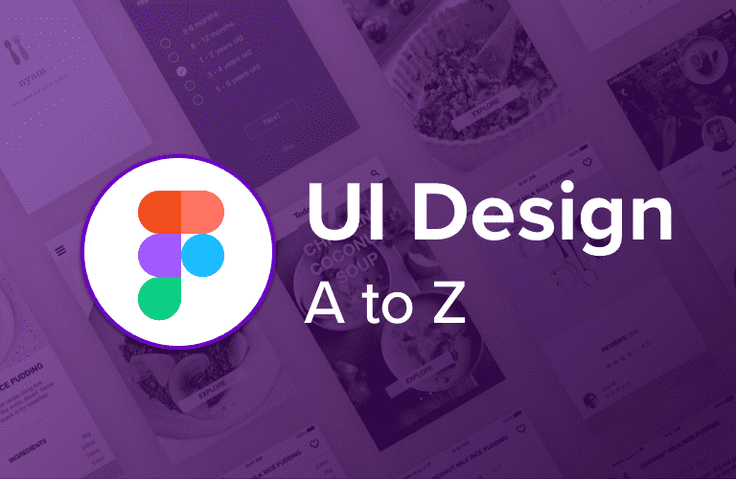
You can develop your UI design theory and practical skills.
We will go through the practical UI design process from start to finish.
Learn the Figma features needed to design UI.
We will show you how to make prototypes from low-fi to high-fi.
Learn the basics of Figma prototyping for user testing and communication.
Learn how to create a Figma/Zeplin handover, the final output of the development stage.

Even beginners and non-majors can gradually
develop UI design skills step by step.
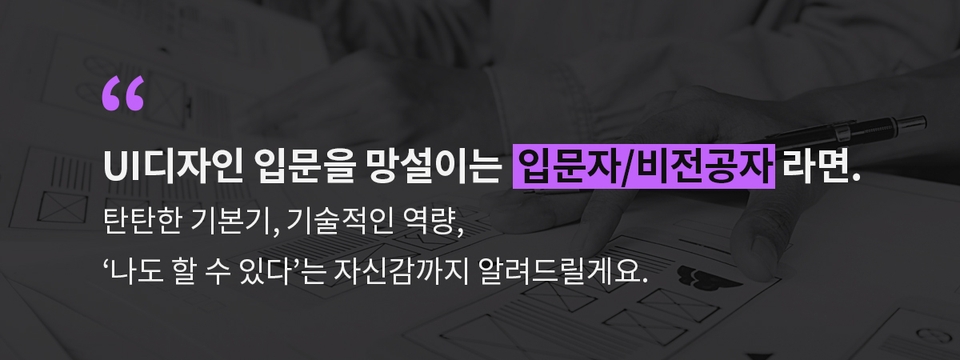
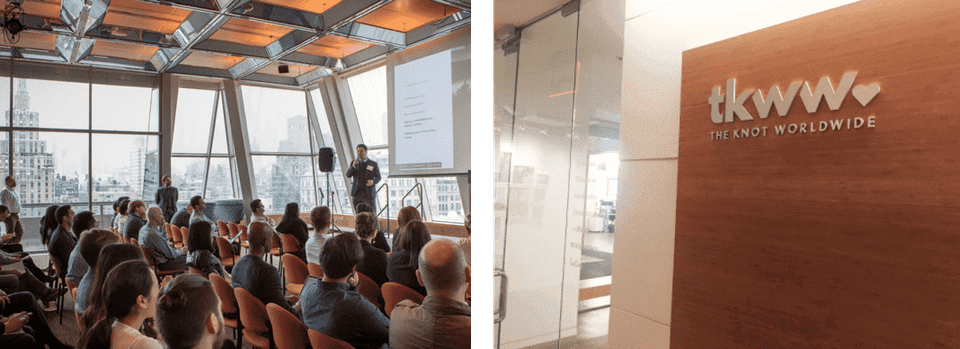
To describe what I do as a product designer, I start with user research work where I learn about users and gather their feedback, then move on to UX design such as creating wireframes and information architecture based on user understanding, and finally handle UI design where I create design systems and produce the final UI design deliverables that actual users will interact with. As a product designer, while I now have ownership over nearly all parts of the UX process - both UX and UI - it wasn't like this from the beginning.
I worked as a planner in Seoul for several years before coming to New York. The work I did at that time mainly involved creating wireframes, or UI specifications, using PowerPoint and conducting user research. Creating wireframes with PowerPoint didn't require visual perfection, so I had no difficulty getting started. However, I thought UI design was not a field I could handle. While I had opportunities to collaborate with UI designers, I never did UI design directly myself.

👉 My appearance when I was working in planning in Seoul and part of the planning documents
I used to think that UI design was only possible for people who were naturally gifted with visual sense or exceptional design abilities. The barrier to acquiring this ability seemed too high for me. However, I came to realize that I needed to become a product designer who handles user research, planning, and UI design all together in order to upgrade my career. To do that, I had to develop UI design skills, which was the biggest challenge for me. Even when I decided to start, I didn't know where or how to begin learning. Still, since I had set a goal, I started looking for ways to achieve it. Fortunately, while searching for methods, I was able to meet great mentors and learn about good approaches.
And once I learned this method, I gained the confidence that 'developing UI design skills is not impossible for me'. Just 3 months after starting to study UI design, I completed my first UI design project, which played a crucial role in landing my first job as a product designer.


👉 UI projects I worked on as a late starter in learning
Through this learning and training process, I discovered that if you know the right methods, even people who don't have exceptional visual sense or haven't majored in design can fully develop UI design skills.
Through this class, I will share the challenges I had to overcome to quickly develop UI design skills and the secrets that helped me overcome them. So I will guide those of you who have similar difficulties to develop UI design capabilities using the Figma tool.

I'd like to ask you one question. 🙋 What you're looking at right now are representative screens from very famous apps. These are beautifully designed screens. What process do you think the designer went through to create these screens? Did they open Figma or Sketch and draw them out in one go?

Image source: Spotify, Airbnb
To share my thoughts on this, most UX/UI design projects go through many processes and considerations before these screens come to fruition, and they are continuously updated to provide better services to users. UI design can be seen as a process of finding solutions to problems within the bigger picture of UX/UI design. In this class, I will teach you about the processes and activities that need to be followed for UI design.
There are reasons for going through these processes. To do UI design well, you shouldn't just jump straight into drawing cool and sharp final UI design screens, but rather go through each step to effectively communicate with team members or clients and ultimately provide the best experience for users. You need to understand why you go through each step and be able to take each step yourself. Through this course, I've prepared lessons so that you can develop the ability to go through each step using Figma and make this process your own, that is, to develop expertise in UI design.

👉 The UI design process I follow when working
Earlier, I mentioned that to do UI design well, you need to follow the UI design process. The purpose of this course is to make this process your own through the lessons. What's most important for this is to actually go through the stages of UI design by following along with the practical chapters and real-world examples in this course through hands-on practice. So let me show you through examples what deliverables you'll create at each stage.
Hand sketching is about thinking of ideas that can solve a given problem and roughly drawing them out. The advantage of sketching is that you can easily modify ideas in a short amount of time. As ideas develop into later stages, the visual completeness increases, which takes more time to make modifications.
Wireframe further refines ideas that come from sketches and defines the functions for each screen and the screens themselves. It also connects the flow between screens. Wireframes can be considered the framework for moving to the UI design stage. When UI planners and UI designers have completely separate roles, wireframes are sometimes handled by UI planners. However, product designers or UX/UI designers should also know how to create wireframes.

👉 This is a sketch I drew that looks like it was drawn with my feet😊😊 But in practice and real work, sketches like this can be incredibly powerful!

👉 Wireframe with defined screens, screen flow diagrams, etc.
Also called a Hi-Fi Prototype, UI design creates visually polished screens based on the wireframes mentioned earlier. At this stage, fonts, colors, icons, and other visual elements reach the level that actual users will experience. In this stage as well, it's important to thoroughly consider what the most suitable experience for users would be. In this lecture, we'll cover design principles you need to know to keep users at the center. If you build practical skills on top of theory, you can become a designer with solid fundamentals! 👍
Prototyping connects each screen created this way, making it appear to users as if it's actually functioning.


👉 The stage of enhancing visual completeness, UI Design
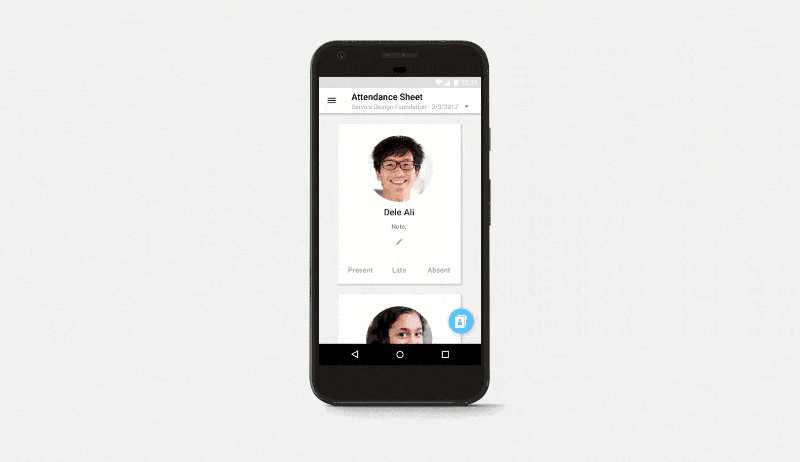
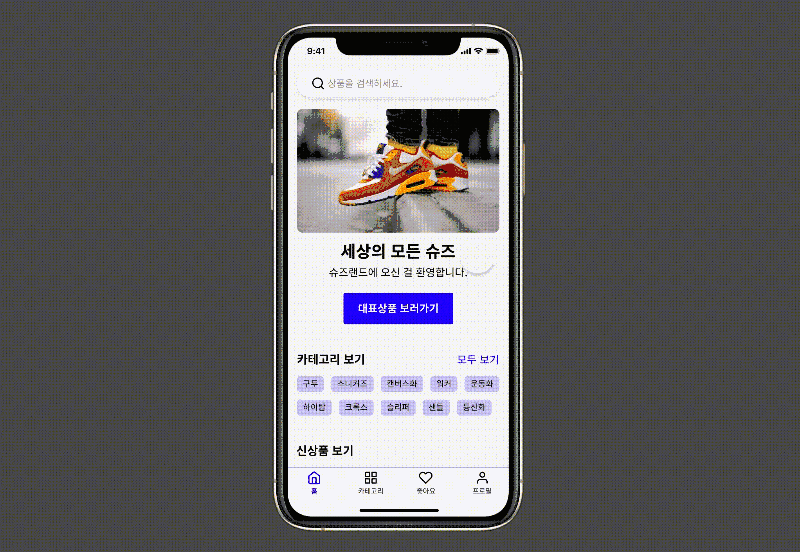
👉 Screens that work without coding through prototyping
Based on the final UI design, I'll show you how to create a design system including style guides and components. Having a design system provides users with a consistent user experience and interface, while allowing designers and developers to work efficiently on design and development, saving time, which makes it extremely powerful in practice. 💪
Finally, hand-off (Hand-Off, HO), which can be considered the final stage of UI design, is the stage where detailed elements such as the pixel size of text or buttons are specifically defined and handed over to developers so that actual development can take place.

👉 Components, a crucial element of design systems

👉 Design deliverables and handoffs created for development
Reference materials for studying design and many useful tips to help beginners gain the skills they want more quickly and easily. I'll share the knowledge and information I've gained from working in UX and UI design for several years. I'll also cover questions that people who learned UI design from me frequently ask. If you have any other questions, please leave them in the comments section^^
After taking the class, once you have acquired UI design skills, you'll be able to create a specific plan for what to do next to achieve your target career, such as becoming a UX/UI designer or product designer. I will provide recommendations and tips on what activities you should engage in to achieve your goals.

First, there are beginners who dream of becoming product designers, UX/UI designers, or UI designers. This includes those without a design background, of course. To achieve this career goal, it's essential to have the ability to do UI design. If you follow this class well, you'll be equipped with basic knowledge, theory, and practical skills, allowing you to accelerate and achieve your desired goals.
Earlier, I mentioned that I felt I lacked visual abilities. I'll share the secrets of how I overcame this so that you too can develop UI design skills. To become a designer, you need to understand the UI design process well and know how to create deliverables for each stage and how to use the tools. After taking this class, you'll be able to achieve this goal.
In this course, we'll gradually progress step by step from Figma's very basic functions like creating shapes and text, all the way to advanced features like UI design and handoff. I've designed the class so that beginners can master Figma and ultimately develop professional UI design skills. In particular, I tried to provide many practical examples through this course. If you follow along with these parts especially diligently, it will be very helpful.
The core of UX and UI design is following and repeating the design process (iteration) until users are satisfied or until the problems users face are resolved. By following the process I mentioned earlier, you can create much more robust apps or services that consider many more aspects for users. After taking this class, you'll become a designer who not only has the ability to design beautiful apps, but also thinks about how to utilize each stage of the process and ultimately how to provide better experiences for users. Learning Figma is to support the technical capabilities and expertise needed to execute each stage.

There are various tools available for each stage of the UI design process. These include Adobe XD, Sketch, Figma, and others. Among them, there doesn't seem to be any app that supports all the activities needed for UI design as comprehensively as Figma does. You can complete almost the entire process with just one app.
When using the Sketch app, you need to use Invision together for the prototyping stage to efficiently share with team members. While the Sketch app does have its own prototyping features, it's an offline-based tool, so there are limitations in effectively sharing online with team members or clients. And for handoff, you need to use Zeplin.
However, with Figma, you can handle everything from wireframing to handoff in a single app. I originally used Sketch but switched to Figma, and I was able to work more effectively and save a tremendous amount of time.

👉 "Figma = Sketch + InVision + Zeplin"
Statistically, Sketch, one of the most widely used UI design tools, cannot be used on Windows. However, since Figma is an online-based tool, it can be used with just a browser like Safari or Chrome. It can be used regardless of which OS you're using, whether Windows or macOS.
Figma is an online-based tool that's really great for real-time collaboration and communication with team members or clients. You can work on design projects in real-time with designers, and it has convenient features for sharing design work with developers, product managers, and others, as well as writing and sharing comments about the work.
.gif)
👉 Real-time collaboration with team members is really convenient.
Figma has many free design templates and plugins created by third parties. By utilizing these effectively, you can increase your design productivity by several times to several dozen times or more. In this course, I will teach you how to use templates and plugins, and especially recommend highly useful templates and plugins to help you develop your UI design skills more easily and quickly.

👉 Figma Plugins and Templates

Q. Do I need to know how to use other tools like Sketch app, Zeplin, or InVision before taking this course?
A. You don't need to know them at all. Figma contains almost all the features needed for UI design. Everything you can achieve through Sketch, InVision, and Zeplin can be done if you master Figma well. In other words, you can create design deliverables by going through all stages such as UI design, prototyping, and handoff (final deliverables for developers) using Figma.
Q. Can non-majors also take this course?
A. Yes, this course is designed for beginners and non-majors. We'll guide you step by step from basic knowledge for UI design to Figma's basic functions, and even advanced knowledge and advanced features. So even if you've been working in a field completely unrelated to design or are a non-major, after taking this course, you'll be able to acquire professional UI design skills.
Q. Are there any prerequisite courses I need to take in advance?
A. If you're someone who knows absolutely nothing about UX and UI design, I think it would be good to first take my "Introduction to UX Design for Beginners" class that I've opened on Inflearn. After taking this class, you'll be able to build overall knowledge of UX and UI design. Most importantly, you'll be able to better understand why you should take this UI design class. If you already have basic knowledge about UX and UI design, it's fine to take this class directly.
Who is this course right for?
Product Design, UX/UI Design Beginner
Those who want to become a UX/UI designer but think they lack visual skills
For those who want to master Figma
For those who want to build a solid foundation in UI design
Need to know before starting?
If you are a beginner, I recommend taking Inflearn's Introduction to UX Design course. Course link: https://inf.run/UmHh
You don't need to know anything about other tools like Photoshop or Sketch apps.😊
5,058
Learners
683
Reviews
306
Answers
4.8
Rating
7
Courses
현재 뉴욕의 글로벌 테크 회사 The Knot Worldwide에서 시니어 프로덕트 디자이너로 일하고 있습니다.
뉴욕에 오기 전에는 서울에서 UI기획자로 일을 했습니다.
브런치 매거진 "디자인, 그리고 프러덕트"와 UX, UI 지식과 정보를 공유하는 "뉴욕 UX디자이너" 인스타그램과 페이스북을 운영하며 디자이너 및 예비 디자이너들과 소통하고 있습니다.
개인적으로는 세 아이👶의 아빠이며 요리🍲, 교육🏫에 관심이 많습니다.

집필 및 강의
• "뉴욕 프로덕트 디자이너가 알려주는 UX디자인 입문 A to Z" 책 출간 (링크: Yes24, 알라딘, 교보문고)
• 퍼블리 아티클 "서비스의 첫 인상을 결정하는 3초: 랜딩 페이지 UX 4가지 원칙" 발행
• Samsung SW Academy for Youth (SSAFY) UX/UI다자인 및 피그마 강사
• 1:1 멘토링 및 기업 강의 진행 (토픽: UX, UI디자인, UX퍼실리테이션, UX/UI 포트폴리오 제작 및 발행)

경험 및 경력
• (현) 뉴욕 The Knot Worldwide 시니어 프로덕트 디자이너
• (전) 서울 Pantech 모바일 앱 UI기획자
• 뉴욕 기반의 다수 스타트업과 UX/UI 컨설팅 프로젝트 진행
• 뉴욕 School of Visual Arts 디자인 대학원 졸업 / 전공: Interaction Design
• 한동대학교 학부 졸업 / 전공: 산업디자인
All
78 lectures ∙ (9hr 5min)
All
483 reviews
4.9
483 reviews
Reviews 2
∙
Average Rating 5.0
5
私は主にWebバックエンドの仕事をしているプログラマーです。フロントエンド業務の核心と見られるUX/UIデザイン業務領域で大勢となっているピグマが気になって、使ってみたい講義を受講することになりました。 講義を頑張って乱後、個人的に感じた点を率直に後期に作成しようと思います。 ● 残念だった点 - ピグマを使った実践例がモバイルサービスでしか行われず、少し残念です。 Webサービスのための本番の例もあればよかったと思いました。これ以外に講義内容自体に惜しい点はほとんど感じませんでした。 - 30分を超えて長すぎる呼吸を要求する講義がちょうど一度ありますが、15分内外程度に分けていただきたいと思う場合がありました。オンライン講義の場合、録画された講義の内容に従いながら理解できなかったり、また聞きたい部分は整理していかなければなりませんが、ある講義の呼吸が長ければ追いつくのが少し難しかったようです。 - 全体の講義で非常に時々あることですが、言葉が詰まって繰り返したり、言葉をたどった部分は集中力をかなり分散させる感じがしますので、そのような部分は編集になればどうだったかと思いました。リアルタイムであれば仕方ないことですが、録画された講義を再生するインフラストラクチャ方式の講義であれば可能ではなかったかという残念が少しあります。 ●良かった点 - まず講師様が過去にデザイン、企画関連業務を通じて味わっていた挫折を踏み、現在UX/UIをはじめとするプロダクトデザイン全体のプロセスを担当して管理する位置に至ったので、初心者の心をよくお見せし、丁寧によく選別して教えてくれると思います。良い講義は才能ある人の成功談からも出てくるのですが、入門者の立場から眺めるとき、ほとんどの良い講義は多くの紆余曲折と難しい点を経験して克服した努力型キャリアから出てくるからです。 - 声が落ち着いて、暖かい声を持っているので、講壇で講義する方ではなく、一緒にコンピュータの前に座って、すぐそばで教えてくれるような感じを受けることができます。外国にいらっしゃるので、私にはそんな機会が届かないのですが、経験上こんなに落ち着いて心配な方と一緒に働いてみてほしいなと思いました。 - デザイン自体に対する海박な知識はもちろん、講師様本人がデザイン作業を楽しんでいくなんてという感じがする場合が講義中途中ずっとあらわれるため、学ぶ立場でもその楽しいエネルギーを受けて楽しく追いつくことができました。 - 講義自体にストーリータリング的要素がよく構成されており、自然に学習に追いつくことができ、頑強に力を与えてくれると思います。 ●結論 - 私は個人的にこの講義がお金が惜しいという感じは全くかかりません。 - 業界に進入を希望する方であるか、関心のある方であれば十分に値段以上をする講義だと思います。 - おそらくピグマに人気に支えられ、ピグマを学習するための良い講義といくつかの資料や書籍が国内でこれからずっと出てくるだろうが、エリック講師のピグマ講義は以後も入門者に良いガイドとなる講義として残ると思います。 。 講義苦労し、バックエンドプログラマーとして視野が広がる良い講義を受講することになり、光栄でした。難しいコロナ時代に健康で、家族みんないつも健康で幸せになることを祈ります。ありがとうございます。
[2021-2-24] Jihoonはとても丁寧で丁寧なレビューをありがとう。ご連絡いただいたフィードバックについていくつかお答えします。^^ 残念な点/改善点関連: 言葉をたどったり繰り返す部分についてご不便をおかけして申し訳ありません。関連していただいたフィードバックを反映し、現在の全体講義映像について、特に音声に対して改善する作業(例えば、馬をたどる部分、重複して同じ内容を連続して話す内容について編集するなど)を進めています。ちなみに、近いうちに全講義の1/3程度についてアップデートが完了する予定です。残りの部分も徐々にすべて更新を行う予定です。受講生の方が少しでもより快適な環境で学習をすることが重要だと考えており、良いフィードバックをいただきありがとうございます。 1章が30分を超える部分も、上記の講義映像改善作業に含まれる予定です。 そしてウェブ画面に対して集中的にUIデザインをすることにも良いフィードバックありがとうございます。今後の講義の改善や啓発に参考にさせていただきます^^ 良い点と結論関連: ピグマに入門してUIデザインをする上で、少しでも助けてくれるので、私は光栄です。入門者の立場で講義をすると言っていただきありがとうございます。この講義を初めて作る時、その部分を念頭に置いて作った部分がありましたが、もう一度心に刻んで入門者の視点から助けを差し上げるように精進しなければなりません。 もう一度丁寧なレビューありがとうございます。いつも元気で今後のこと、計画されることすべてが成し遂げられることを深く応援します。 [2021-03-23] 上記の講義映像の改善は現在、約50パーセントが完了しました。残りの部分も改善作業が進行中であり、アップデートになり次第共有いたします^^
Reviews 2
∙
Average Rating 5.0
5
私はITジュニアの企画者です。 講義を聞きながら一番良かった点は、ピグマを扱う方法をほとんど教えてくれ、たくさん使うスキルを強調して教えてくれた点です。 改善していただきたいのはスピーチ方式ですが、馬に強弱が少なく、馬の真ん中に休む部分が多いので残念でした。 しかし、欠点を相殺するのに十分な講義でした。 UX企画者としてアメリカで就職するのが目標の一つですが、ブランチやインスタ文を見てロールモデルにして努力してみましょう。
よく使うスキルをお知らせした部分が役に立ったとはやりがいを感じます。スピーチや馬の途中で休む部分については私の不足を感じました。講義を改善し発展させるのに参考にしましょう。とても良いフィードバックありがとうございます。 UX企画者で米国就職を目指す部分については、ご不明な点や私がお手伝いできる部分がある場合は、オープンカトク1:1にお問い合わせください。ちなみに、私は土宗韓国人で韓国から大学まで教育を受けて職場生活をしてアメリカ大学院留学をしてから就職したケースです。
Reviews 2
∙
Average Rating 5.0
5
"入門者のためのUXデザインの概論"を聞いて、本講義まで受講しています。 UXデザインの基本的な知識からピグマツールの取り扱い方や、実際にデザインをどのように進めるべきかについての講義まで、非専攻者として初めて入門する際に多くの困難がありました。
punky94さん、ありがとうございました。私がこの講義を作ったときに最も多く考えた方が非専攻者を含む入門者であり、そのような方がUIデザインの入門をして実務能力を育てるようにすることが目標でしたが、役に立ったと言うのでこれよりもやりがいがないようです。目指すことすべてが成し遂げるのを応援します~!
Reviews 1
∙
Average Rating 5.0
5
こんにちは。ジュニアプロダクトデザイナーです。早い時間内にFigmaの概念とスキルを身につけることができてとてもよかったです。 (+マインドセットとUXの概念はおまけです)実際には、Adobe XDしか使用できませんでした。ところが就職しようとすると Figma や Sketch を求めるところが多かったんですよ。だから聞いた講義です!おかげで今実務でフィグマをうまく活用しています:)
この講義を通じてスキルを身につけて実務に使用までしているとは、助けを少しでも申し上げることができて感謝して嬉しいです。これからやろうとしていることすべてが成し遂げることを応援します〜!
$63.80
Check out other courses by the instructor!
Explore other courses in the same field!